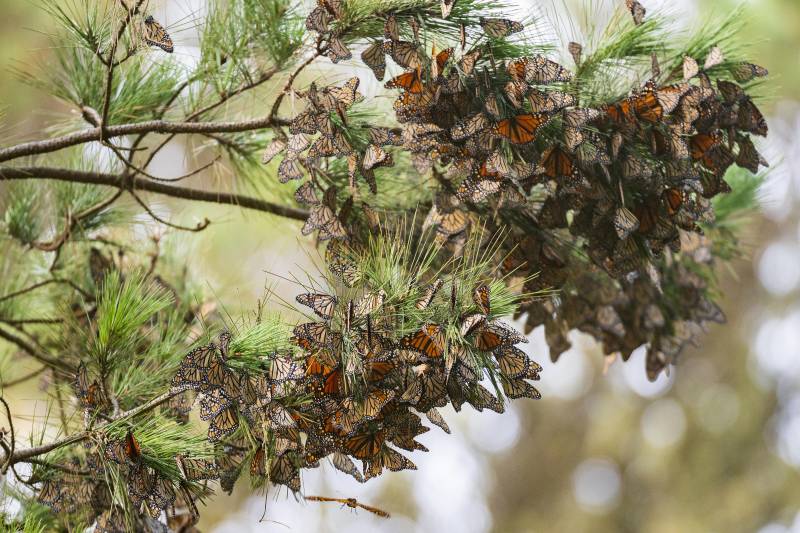“That’s not the future,” he said. “The threats are so widespread now that it’s even affecting widespread species, so we got to take this on. Conservation on a large scale, that’s what we got to figure out how to do as a society.”
Transcript:
MARY LOUISE KELLY, HOST:
The monarch butterfly is one of the most recognizable insects in the country. Its orange and black wings can be spotted in nearly every U.S. state. And yet soon, federal wildlife officials will decide whether these butterflies should be listed under the Endangered Species Act. NPR’s Nathan Rott reports.
NATHAN ROTT, BYLINE: The monarch butterfly presents a bit of a paradox. On one hand, yeah, you can pretty much find them anywhere in the continental U.S.
KAREN SINCLAIR: One up there?
ROTT: There’s one right there.
SINCLAIR: Oh, yeah, there is one right over there. That’s a good sign.
ROTT: Like I did while talking to Karen Sinclair, a biologist at the U.S. Fish and Wildlife Service at a park in Southern California. But…
SINCLAIR: But we’re seeing less monarch butterflies.
ROTT: …There are fewer of them overall. Sinclair trains volunteers to count monarchs every year in Ventura at places like this park, where the migrating insects reliably cluster come winter.
SINCLAIR: And the number of times I have had the locals walk up to us, and they go, oh, what are you doing? We’re like, oh, we’re counting monarchs. The monarchs are here. And, like, oh, my gosh. I used to see monarchs all the time when I was a kid, you know? You could see them just dripping off the trees. And I didn’t think they were here anymore, you know? I haven’t seen them like that in a long time.
ROTT: There are two big populations of monarch butterflies in the U.S. The eastern population, which migrates between overwintering sites in Mexico to Canada, has dropped by more than 80% since the ’90s. For the western population, which migrates between the California coast and the Mountain West…
SINCLAIR: Now there’s less than 5% of what there used to be.
ROTT: The decline has spurred countless conservation efforts by states, communities, tribes, wildlife groups and landowners all over the country. But, says Emma Pelton…
EMMA PELTON: But there’s been really good evidence that we are not scaling to the levels that we need for recovery.
ROTT: Pelton is an endangered species biologist at the Xerces Society for Invertebrate Conservation. In one of the groups, it’s been calling for the U.S. Fish and Wildlife Service to list the monarch butterfly as threatened, not endangered.
PELTON: Yeah. I don’t think anyone has argued for endangered. I don’t think it qualifies.
ROTT: Which is an important distinction because when a plant or animal is listed as endangered, it gets the top level of federal protection. Like this species is nearly extinct. Do not touch or mess with it. If a species is listed as threatened, the protections can be a little more flexible to accommodate for the people interacting with the species, which Pelton says for the monarch is somewhat necessary.
PELTON: We really want to see some common-sense middle ground about exempting activities that are beneficial. This is a unique animal. It’s in classrooms. It’s in homes. It’s in gardens. This is something used for education and outreach. So we don’t want that to, you know, be taken off the plate.
ROTT: And she doesn’t want a potential listing to hamper existing conservation efforts. And that’s the challenge. Monarch butterfly populations are declining for three main reasons — habitat loss, the use of pesticides and climate change. So, perhaps unsurprisingly, when Brigit Rollins, a staff attorney at the National Agricultural Law Center, talks to farmers in the heartland, people who she says are working to conserve monarchs…
BRIGIT ROLLINS: There’s a lot of concern about how listing the monarch butterfly could impact use of pesticides.
ROTT: And how it could impact where they plow or plant. Rollins says she’s expecting the Fish and Wildlife Service to recommend listing the monarch when it makes its decision in early December. But she notes it would only be a proposed rule, subject to public comments, revisions and, soon, a new presidential administration.
ROLLINS: We know that during the Trump administration, the administration was interested in rolling back a lot of environmental regulations.
ROTT: Including many long-held aspects of the Endangered Species Act.
ROLLINS: So I would not be surprised to see that again.
ROTT: Still, advocates and scientists like Matt Forister, a plant and insect ecologist at the University of Nevada, Reno, are excited to see how the federal government proposes to protect an insect that lives practically everywhere because, he says, it’s necessary.
MATT FORISTER: We all grew up with this idea that there — you know, there’s National Parks, right? And, like, they’ve got a fence around them, and that’s going to be fine. But nothing’s fine now, right? All threats are completely pervasive now, and we got to deal with that.
ROTT: We’ve got to figure out, he says, how to do conservation at a large scale. Nathan Rott, NPR News, Ventura, California.
(SOUNDBITE OF KACEY MUSGRAVES SONG, “BUTTERFLIES”)

